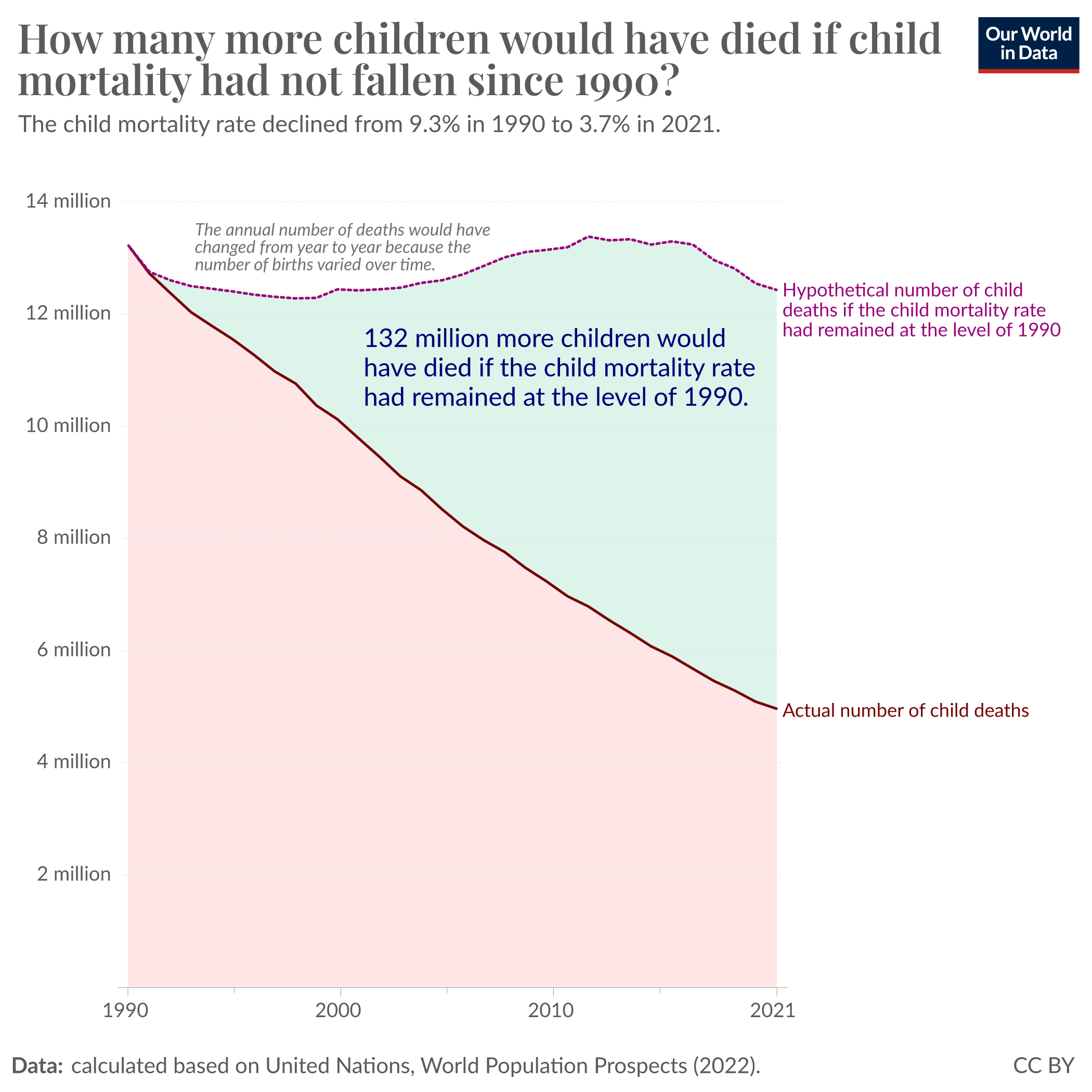How many children did not die thanks to progress in global health?
Thanks to improvements in global health, more than 100 million children have been saved since 1990.
Declining death rates among children have been one of humanity’s most important achievements. Across the world, countries have dramatically reduced child mortality. I think we should celebrate this extraordinary achievement, using it as encouragement to reduce child mortality further.
But it can seem hard to celebrate something that is not happening. So, I wanted to turn things around. Rather than focusing on the absence of child deaths, I want to highlight the presence of people who are here today thanks to the progress in global health.
To make the millions who were saved by progress in global health visible, I am asking a simple question: how many more children would have died if the global child mortality rate had not declined?
To answer this question, we have to pick a baseline. Let’s start in 1990. If I had gone back further in time, this figure would have been even higher because the rate of child mortality was much higher in the past.
The chart shows the answer. A generation ago, in 1990, the global child mortality rate was 9.3%. The dashed purple line shows the number of children who would have died if the mortality rate had stayed constant. More than 12 million children would have died every year.
The actual number of child deaths declined to 5 million per year. This is shown by the dark red line. This was achieved because the global mortality rate of children declined to 3.7% in 2021.
The difference between the two lines shows us how many more children would have died if the world had made no progress. In total, 132 million more children would have died across these 31 years.1
In short, thanks to progress in global health since 1990, 132 million more people are alive in our world today.

Acknowledgments: I would like to thank Hannah Ritchie for her helpful comments on drafts of this essay and the visualizations.
Explore more research and data on Our World in Data:
Endnotes
The calculation assumes that the reduction of child mortality did not affect the number of births in the world, which is a simplification and means that my estimate of 132 million children saved is an underestimate. The actual number of children who would have died would have been even higher.
This is because if the world had truly made no progress against child mortality, some families would have likely had more children. This is due to two effects, which both have particularly terrible names in the demographic literature:
- The first effect is called "child replacement" and describes the fact that parents who experience the death of a child might deliberately decide to have an additional child to “replace” the one who died.
- The second effect is called “child hoarding." Demographers speak of hoarding when a family decides to have more births than their desired number of children to protect themselves against the possibility of future high mortality in the family. The motivation for this is best understood in contrast to the motivation for replacement. “Replacement” is the response to the experience of a child's death, while “hoarding” is the response to the expectation of future child mortality.
Both of these effects would have led to a higher number of births, and at a given rate of child mortality, this would have led to a higher number of child deaths.
Cite this work
Our articles and data visualizations rely on work from many different people and organizations. When citing this article, please also cite the underlying data sources. This article can be cited as:
Max Roser (2024) - “How many children did not die thanks to progress in global health?” Published online at OurWorldInData.org. Retrieved from: 'https://ourworldindata.org/children-saved-global-health' [Online Resource]BibTeX citation
@article{owid-children-saved-global-health,
author = {Max Roser},
title = {How many children did not die thanks to progress in global health?},
journal = {Our World in Data},
year = {2024},
note = {https://ourworldindata.org/children-saved-global-health}
}Reuse this work freely
All visualizations, data, and code produced by Our World in Data are completely open access under the Creative Commons BY license. You have the permission to use, distribute, and reproduce these in any medium, provided the source and authors are credited.
The data produced by third parties and made available by Our World in Data is subject to the license terms from the original third-party authors. We will always indicate the original source of the data in our documentation, so you should always check the license of any such third-party data before use and redistribution.
All of our charts can be embedded in any site.

